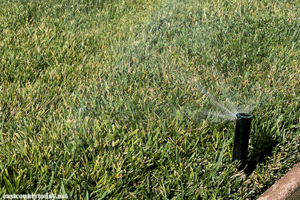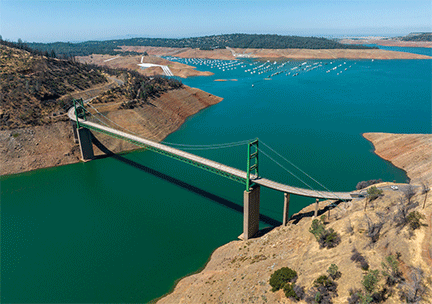SACRAMENTO, Calif. – Conserving water has become a way of life in California, especially as projections forecast warmer, drier conditions. The State’s new water year has begun and with it comes fresh concerns about a fourth year of extreme drought for the state.
California’s water year runs from October 1 to September 30 and is the official 12-month timeframe used by water managers to compile and compare hydrologic records.
Water Year 2022 ended on Friday and featured continued extreme drought with historically dry months and a record-shattering heatwave. Now, the focus shifts to the months ahead with state officials preparing for a fourth dry year.
Over the past 12 months, California saw extreme swings between record-breaking storms and dry conditions driven by our changing climate. In October 2021, parts of Northern California experienced the highest single-day rain totals ever, followed by a dry November and then a record snowfall in parts of the Sierra in December. Conditions took a turn again with the driest January, February, and March in over 100 years.
Despite some rain recorded in parts of California in September, uncertainty remains about what the new water year may bring. Long-range forecasting suggests warmer and drier than average conditions to persist.
“This is our new climate reality, and we must adapt. As California transitions to a hotter, drier future, our extreme swings from wet and dry conditions will continue,” said DWR Director Karla Nemeth. “We are preparing now for continued extreme drought and working with our federal, state, local, and academic partners to plan for a future where we see less overall precipitation and more rain than snow.”
Water Year 2022 ended with statewide precipitation at 76 percent of average. Statewide reservoir storage is 69 percent of average for this time of year. Lake Oroville, the State Water Project’s largest reservoir, sits at 64 percent of average for this time of year.
The current drought from 2020 to 2022 is now the driest three-year period on record, breaking the old record set by the previous drought from 2013 to 2015. This extended, extreme drought is having an impact on all Californians, especially the State’s most vulnerable communities. California is aggressively addressing the urgent need for financial and technical support for water resilience projects across California. To date, DWR has provided over $480 million in grant funding through its Small Community and Urban and Multi-benefit Drought Relief programs. This summer, the Legislature approved hundreds of millions in additional funding and programs to support these communities.
Californians can all do their part to adapt to the hotter, drier future by making water conservation a way of life. Governor Newsom has asked all Californians to reduce water usage at home by 15 percent. Learn more at saveourwater.com. DWR also recently announced a series of actions to make water conservation more affordable through financial assistance and tax exemptions.
Californians can access current water conditions in real time at California Water Watch, a new website launched by DWR. This website will help Californians see their local hydrological conditions, forecasts, and water conditions down to their address or their local watershed. The site presents data from a variety of sources and allows the public to obtain a quick snapshot of local and statewide water conditions. Complete data for Water Year 2022 is available now.
DWR Takes Actions to Support State’s Future Water Supply Strategy
 SACRAMENTO, Calif. – the Department of Water Resources (DWR) announced new steps that, if approved, could save enough water to supply 4.7 million Californians annually while making conservation more affordable through financial assistance and tax exemptions. The actions improve long-term water conservation and reduce wasteful outdoor water use as California adapts to a hotter, drier future driven by climate change.
SACRAMENTO, Calif. – the Department of Water Resources (DWR) announced new steps that, if approved, could save enough water to supply 4.7 million Californians annually while making conservation more affordable through financial assistance and tax exemptions. The actions improve long-term water conservation and reduce wasteful outdoor water use as California adapts to a hotter, drier future driven by climate change.
“We have the tools to make it easier than ever for Californians to conserve water and we’re taking action to get it done. It will take forward-thinking practices to ensure that we’re managing our water resources resiliently now and for the future,” said DWR Director Karla Nemeth. “From regulatory recommendations to funding for lawn replacement and water conservation, DWR is putting California on the path to achieve historic water savings.”
The new actions will build on California’s ongoing long-term efforts to make water conservation a way of life while advancing water efficiency efforts outlined in California’s Water Supply Strategy: Adapting to a Hotter, Drier Future. The plan, released by Governor Newsom this summer, sets a target of securing 500,000 acre-feet of additional water per year through increased efficiency and conservation.
DWR will be implementing and supporting actions that include:
Outdoor Water Use Recommendations
To help prepare for a hotter and drier future, DWR has submitted outdoor water use efficiency recommendations to the State Water Resources Control Board. With outdoor water use accounting for 50 percent of urban resident water use on average, the recommendations outline standards that would provide urban retail water suppliers with a framework to support more efficient outdoor residential water use. The framework will also include standards for the irrigation of large commercial, industrial, and institutional (CII) landscapes in their service areas.
DWR’s outdoor water use recommendations combined with indoor residential water use recommendations submitted in November 2021 would result in expected long-term water savings of 450,000 acre-feet per year starting in 2030 – enough water to supply about 1.6 million homes or about 4.7 million residents for both indoor and outdoor annual needs. The recommendations would also result in near-term savings of 100,000 acre-feet a year starting in 2023. DWR’s recommendations will be evaluated by the State Water Resources Control Board through a formal rulemaking process, which will include additional analysis, engagement, and opportunity for public comment.
Indoor Water Use Legislation Signed
California also recently took additional steps to increase indoor water use savings with Governor Newsom’s signing of Senate Bill 1157 (Hertzberg), which adopts recommendations made by DWR and the State Water Board last year to reduce indoor water use targets to 47 gallons per day by 2025 and 42 gallons by 2030. By adjusting indoor water use standards to reflect the joint recommendation of DWR and the State Water Board, the legislation will help increase water conservation and water use efficiency, ensuring a more water-resilient future for California.
Financial Assistance for Turf Transition and Conservation
DWR has developed a set of funding programs that will help build resiliency in all communities including underrepresented communities and Tribes. The funding programs include financial assistance for projects that strengthen resilience in urban communities, turf transition for residential and commercial landscapes and water conservation programs for urban water suppliers. DWR’s programs will help to clear some of the hurdles that underserved communities face with direct install programs and support for local water agencies, while also helping build resiliency with equity in mind. DWR plans to release these grant programs in October. These new programs will build on the momentum created by the millions of dollars in grant funding that has been distributed by DWR in 2022.
Turf Tax Exemption
For those making smart water decisions to replace their lawns now and in the future, Governor Newsom signed Assembly Bill 2142 (Gabriel), which will exempt from state income tax calculations any grant, rebate or additional financial assistance awarded from a state or local agency for turf transition. The law will provide the exemption through tax year 2027.
These announced actions come on the heels of state and local leaders gathering today at the Bay View Google Campus to discuss the urgent need for all Californians, including businesses, to conserve water amid extreme drought. With California experiencing a climate transformation bringing hotter and drier conditions, each individual act of conservation makes a difference.
For more information on water use efficiency and the recommended standards, visit DWR’s Urban Water Use Efficiency Standards webpage. For information about other DWR and State drought response efforts and funding programs, visit drought.ca.gov

